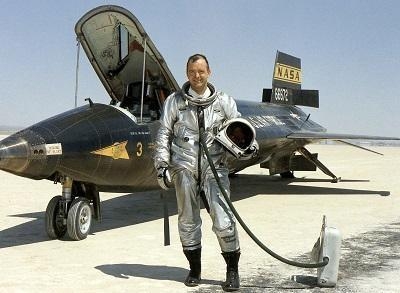Fri, May 09, 2014
Before The Term Astronaut Had Even Been Invented A Few Research Pilots Flew To The Edge Of Space. William H. Dana Was One Of Those Few
One of the nation’s most respected aerospace pioneers has passed away. Distinguished research pilot and aeronautical engineer William Harvey Dana died on May 6, 2014 after a lengthy illness.

Following four years in the Air Force, Dana was hired as an aeronautical research engineer at the NASA High-Speed Flight Station (now NASA's Armstrong Flight Research Center) on Oct. 1, 1958, the very same day that NASA was established. His first assignments included development of a rudimentary performance simulator for the X-15 rocket plane and stability and control research involving the F-107A fighter prototype.
In September 1959 he transferred to the center's Flight Operations Branch as a research pilot. Over the next three decades he conducted flight experiments in a wide variety of aircraft including the rocket powered X-15 and the wingless lifting bodies. Dana flew to the edge of space in the X-15, attaining a maximum speed of Mach 5.53 (3,897 mph) and a maximum altitude of 306,900 feet (nearly 59 miles).
He was then assigned to fly the HL-10, M2-F3, and X-24B lifting bodies to validate engineers’ assertions that such vehicles could be precisely controlled during approach and landing, and providing NASA with the confidence needed to proceed with designs for the space shuttle orbiter.
Retired NASA research test pilot Bill Dana was all smiles when he was awarded civilian astronaut wings during a 2005 ceremony for his flights above 50 miles altitude in the X-15 rocket plane in the 1960s.
In addition to his rocket powered flights Dana also flew numerous other research and special-purpose aircraft. Because of his demonstrated leadership and extraordinary service in flight research, Dana was appointed chief pilot in 1986 with responsibility for recruiting, developing and training the center's cadre of research pilots. He also served as assistant chief of the Flight Operations Division.
Dana was awarded civilian astronaut wings on Aug. 23, 2005 for two of his X-15 flights that exceeded 50 miles altitude. That honor came nearly 40 years after the flights occurred because at the time of the X-15 program, NASA did not confer astronaut wings on its pilots.
(Image provided by NASA)
More News
Also: Vertical Flight Society, NBAA Maintenance Conference, GA Honored, AMT Scholarship For the first time, students from Embry-Riddle’s Daytona Beach, Florida, campus took t>[...]
Hazardous Weather Information Summary of significant meteorological information (SIGMET/WS), convective significant meteorological information (convective SIGMET/WST), urgent pilot>[...]
"The need for innovation at speed and scale is greater than ever. The X-62A VISTA is a crucial platform in our efforts to develop, test and integrate AI, as well as to establish AI>[...]
(FAA) Inspector Observed That Both Fuel Tanks Were Intact And That Only A Minimal Amount Of Fuel Remained In Each Analysis: According to the pilot, approximately 8 miles from the d>[...]
“Pyka’s Pelican Cargo is unlike any other UAS solution on the market for contested logistics. We assessed a number of leading capabilities and concluded that the Pelica>[...]
 Airborne-Flight Training 05.09.24: ERAU at AIAA, LIFT Diamond Buy, Epic A&P
Airborne-Flight Training 05.09.24: ERAU at AIAA, LIFT Diamond Buy, Epic A&P ANN's Daily Aero-Term (05.07.24): Hazardous Weather Information
ANN's Daily Aero-Term (05.07.24): Hazardous Weather Information Aero-News: Quote of the Day (05.07.24)
Aero-News: Quote of the Day (05.07.24) NTSB Final Report: Cessna 150
NTSB Final Report: Cessna 150 Aero-News: Quote of the Day (05.08.24)
Aero-News: Quote of the Day (05.08.24)



